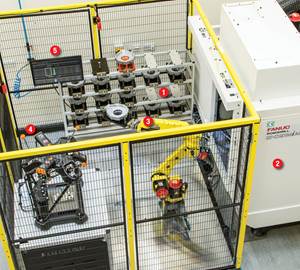The Starting Point for Machine Tool Monitoring: Data Analysis Is an Emotional Choice
For machine shops, the transformation that data-driven manufacturing promises to bring begins with machine monitoring, and there is a human component to this.
Share


Hwacheon Machinery America, Inc.
Featured Content
View More







Data hold the promise to transform manufacturing. And with that one word, “data,” I am referring to a lot. I mean the increasing ease and advancing capabilities for interconnecting machines, sensing and gathering useful information, guiding machines automatically, and finding insights in the data flowing out of manufacturing systems. How all of this capability will affect manufacturing is unclear, and much of the promise in these areas is still in the future, but it is the near future. For machine shops, though, there is an obvious starting point. The first step is to monitor CNC machines—networking CNCs to report data into a single, unified system for analyzing machining performance. Just this step is transformative, as many shops have discovered.
Indeed, the step is emotional. Machine tool data monitoring is an analytical step with emotional implications. Shop leaders must be prepared emotionally to face the data and act on what the data reveal.
I spoke about this with Refresh Your Memory, developers of FactoryWiz software. With software and hardware interfaces for gathering status data from many machine and control types, old and new, the system frequently gets used in shop-wide monitoring applications. According to Richard Hefner, the company’s VP of engineering, one of the first findings in these applications is generally that the shop is not as efficient as it thinks. Owners like to assume their shops run at efficiencies of 70 percent or better, but when the data come in, a capacity utilization percentage in the mid-30s or even the mid-20s is generally where shops discover they are starting, he says.
Such findings are so uncomfortable and so counterintuitive that a widely dispersed group will not be able to face them effectively. “Machine monitoring needs to have a champion,” Mr. Hefner believes. One person in the shop ought to be tasked with seeing the data, seeing the gaps of lost capacity the data reveal, and proceeding with the investigation to find the cause(s) of inefficiency that can be prevented in the future. That is, one person should be on the hook for the hard work of looking past assumptions and emotions and believing the data.
But if emotional response is a challenge, it is also a power to be harnessed. According to Mr. Hefner, “The number one determinant of successful machine monitoring deployment is having a big TV display out in the shop.” On that real-time display, he says, “Nobody wants to be the one whose machine status indicator is blinking.” Productive time losses get addressed quickly and directly. Just this effect is generally enough to deliver a 15-percent gain in utilization, he says, and the gain usually sticks.
Part of the reason it sticks is because machine monitoring, when done well, elevates the efficiency of the process and the worth of the people at the same time. This is its most powerful emotional win. Operators discover they are not getting hounded for productivity interruptions. Instead, they are valuable sources of insight because they are the ones who see and often know how to solve the problems that the data reveal to be significant.
There is a big story here. Not only is data-driven and data-enabled technology in manufacturing advancing in many ways, starting with machine monitoring, but it also has a human component that will figure in. So, starting this month, we are increasing our commitment to reporting this story with a new, regular column by Matt Danford, “Data Matters.” Matt has been writing about manufacturing technology for more than a decade, and now he has taken on data-driven manufacturing as a topic he will give monthly attention. In manufacturing at large just as in your shop, the promise of data will be revealed step by step, and we are looking forward—indeed, we are committed emotionally—to making that journey with you.
Related Content
5 Stages of a Closed-Loop CNC Machining Cell
Controlling variability in a closed-loop manufacturing process requires inspection data collected before, during and immediately after machining — and a means to act on that data in real time. Here’s one system that accomplishes this.
Read MoreHow this Job Shop Grew Capacity Without Expanding Footprint
This shop relies on digital solutions to grow their manufacturing business. With this approach, W.A. Pfeiffer has achieved seamless end-to-end connectivity, shorter lead times and increased throughput.
Read MoreProcess Control — Leveraging Machine Shop Connectivity in Real Time
Renishaw Central, the company’s new end-to-end process control software, offers a new methodology for producing families of parts through actionable data.
Read MoreProtecting Your Automation Investments
Shops need to look at their people, processes and technology to get the most of out their automation systems.
Read MoreRead Next
Registration Now Open for the Precision Machining Technology Show (PMTS) 2025
The precision machining industry’s premier event returns to Cleveland, OH, April 1-3.
Read MoreBuilding Out a Foundation for Student Machinists
Autodesk and Haas have teamed up to produce an introductory course for students that covers the basics of CAD, CAM and CNC while providing them with a portfolio part.
Read More5 Rules of Thumb for Buying CNC Machine Tools
Use these tips to carefully plan your machine tool purchases and to avoid regretting your decision later.
Read More





































.jpg;maxWidth=300;quality=90)

.jpg;maxWidth=300;quality=90)







